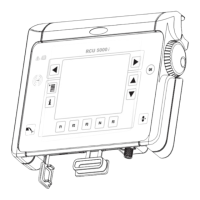115
EN
- A high droplet detachment current raises the pulsing or droplet detachment energy
- A low droplet detachment current decreases the pulsing or droplet detachment energy
Arc (static) Wire feed speed
The wire feed speed [m/min] regulated via a pulse generator guarantees a controlled
speed value on the feed rollers.
Effects of an excessively high wire feed speed:
- arc too short
- The wire electrode is not sufficiently melted - heavy spatter due to wire electrode pen-
etrating the welding material
Effects of an excessively low wirefeed speed:
- arc too long
- scoring may appear around the weld seam
- wire electrode may weld fast to the contact tube
Voltage command value
This parameter gives the voltage command value in [V] for controlling the arc length.
Effects of excessively high voltage:
- arc too long
- scoring may appear around the weld seam
- wire electrode may weld fast to the contact tube
Effects of excessively low voltage:
- arc too short
- The wire electrode is not sufficiently melted - heavy spatter due to wire electrode pen-
etrating the welding material
Fact-I_b-control (pi)
Effect of deviations [%] on the base current (0 - 50)
Fact-I_p1-control (pi)
Effect of deviations [%] on the pulsing current (0 - 50)
Tau current drop
Time of transition [ms] from a linear slope to the droplet detachment current (0 - 5)
0 = hard transition, loud arc noise
5 = soft transition, softer arc noise
Droplet detachment current
The droplet detachment current [A] is effective in the decreasing steep edge of a pulse,
and serves to produce the best droplet detachment. The droplet detachment current must
be greater than the base current, otherwise there is a risk of an arc breakNô kein Strom-
abfall
Droplet-detachment time
Length of time [ms] that the droplet detachment current is active (0 - 50)
0 = no droplet detachment current
Pulse frequency
The pulsing frequency [Hz] is determined by the droplet size and is proportional to the
wirefeed speed.

